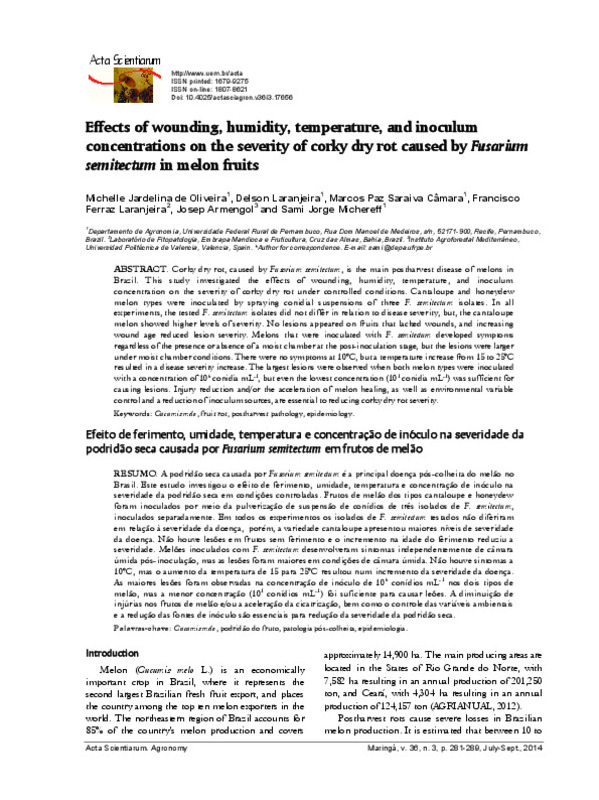JavaScript is disabled for your browser. Some features of this site may not work without it.
Buscar en RiuNet
Listar
Mi cuenta
Estadísticas
Ayuda RiuNet
Admin. UPV
Effects of wounding, humidity, temperature, and inoculum concentrations on the severity of corky dry rot caused by Fusarium semitectum in melon fruits
Mostrar el registro sencillo del ítem
Ficheros en el ítem
| dc.contributor.author | De Oliveira, Michelle Jardelina
|
es_ES |
| dc.contributor.author | Laranjeira, Delson
|
es_ES |
| dc.contributor.author | Saraiva Camara, Marcos Paz
|
es_ES |
| dc.contributor.author | Ferraz Laranjeira, Francisco
|
es_ES |
| dc.contributor.author | Armengol Fortí, Josep
|
es_ES |
| dc.contributor.author | Michereff, Sami Jorge
|
es_ES |
| dc.date.accessioned | 2016-09-08T10:14:29Z | |
| dc.date.available | 2016-09-08T10:14:29Z | |
| dc.date.issued | 2014-07 | |
| dc.identifier.issn | 1679-9275 | |
| dc.identifier.uri | http://hdl.handle.net/10251/69091 | |
| dc.description.abstract | [EN] Corky dry rot, caused by Fusarium semitectum, is the main postharvest disease of melons in Brazil. This study investigated the effects of wounding, humidity, temperature, and inoculum concentration on the severity of corky dry rot under controlled conditions. Cantaloupe and honeydew melon types were inoculated by spraying conidial suspensions of three F. semitectum isolates. In all experiments, the tested F. semitectum isolates did not differ in relation to disease severity, but, the cantaloupe melon showed higher levels of severity. No lesions appeared on fruits that lacked wounds, and increasing wound age reduced lesion severity. Melons that were inoculated with F. semitectum developed symptoms regardless of the presence or absence of a moist chamber at the post-inoculation stage, but the lesions were larger under moist chamber conditions. There were no symptoms at 10°C, but a temperature increase from 15 to 25°C resulted in a disease severity increase. The largest lesions were observed when both melon types were inoculated with a concentration of 106 conidia mL-1, but even the lowest concentration (101 conidia mL-1) was sufficient for causing lesions. Injury reduction and/or the acceleration of melon healing, as well as environmental variable control and a reduction of inoculum sources, are essential to reducing corky dry rot severity | es_ES |
| dc.language | Inglés | es_ES |
| dc.publisher | Universidade Estadual de Maringá | es_ES |
| dc.relation.ispartof | Acta Scientiarum. Agronomy | es_ES |
| dc.rights | Reconocimiento (by) | es_ES |
| dc.subject | Cucumis melo | es_ES |
| dc.subject | Fruit rot | es_ES |
| dc.subject | Postharvest pathology | es_ES |
| dc.subject | Epidemiology | es_ES |
| dc.subject.classification | PRODUCCION VEGETAL | es_ES |
| dc.title | Effects of wounding, humidity, temperature, and inoculum concentrations on the severity of corky dry rot caused by Fusarium semitectum in melon fruits | es_ES |
| dc.type | Artículo | es_ES |
| dc.identifier.doi | 10.4025/actasciagron.v36i3.17656 | |
| dc.rights.accessRights | Abierto | es_ES |
| dc.contributor.affiliation | Universitat Politècnica de València. Departamento de Ecosistemas Agroforestales - Departament d'Ecosistemes Agroforestals | es_ES |
| dc.description.bibliographicCitation | De Oliveira, MJ.; Laranjeira, D.; Saraiva Camara, MP.; Ferraz Laranjeira, F.; Armengol Fortí, J.; Michereff, SJ. (2014). Effects of wounding, humidity, temperature, and inoculum concentrations on the severity of corky dry rot caused by Fusarium semitectum in melon fruits. Acta Scientiarum. Agronomy. 36(3):281-289. doi:10.4025/actasciagron.v36i3.17656 | es_ES |
| dc.description.accrualMethod | S | es_ES |
| dc.relation.publisherversion | https://dx.doi.org/10.4025/actasciagron.v36i3.17656 | es_ES |
| dc.description.upvformatpinicio | 281 | es_ES |
| dc.description.upvformatpfin | 289 | es_ES |
| dc.type.version | info:eu-repo/semantics/publishedVersion | es_ES |
| dc.description.volume | 36 | es_ES |
| dc.description.issue | 3 | es_ES |
| dc.relation.senia | 279658 | es_ES |








